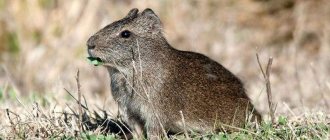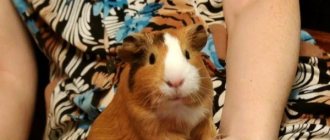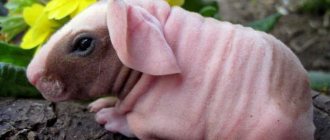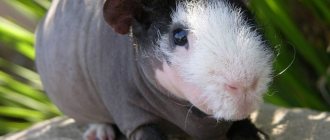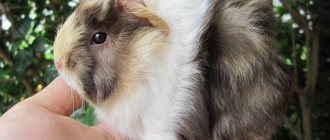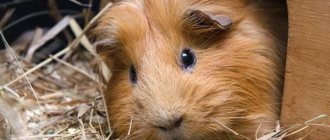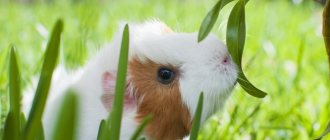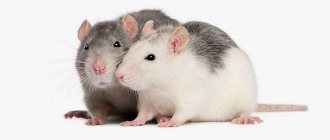Guinea pigs have long been popular pets. These cute rodents are easy to purchase in pet stores or at the Bird Market. However, the animals sold there are often outbred (crossbred) because they do not have any documents confirming their origin. Of course, this will not prevent the pig from becoming a pet, but if you plan to engage in serious breeding of these animals, then such a “breeding breeder” can please you with an unpredictably diverse offspring. For breeding, you should purchase purebred pigs of known origin. Today there are a number of clubs for guinea pig lovers that coordinate the activities of breeders and organize exhibitions. In these clubs you can purchase young animals of different breeds with pedigrees. The choice of breeds is quite large: from the already familiar smooth shorthaired, Peruvian and Abyssinian, to a variety of rare and exotic ones (curly Texels, crested Cresteds, etc.). In general, today there are more than 80 breeds of guinea pigs, differing in the structure, length and color of their coat, and thanks to the work of breeders, more and more new ones are appearing. The most popular marine breeds will be discussed in this article.
There are various classifications of guinea pig breeds in the literature. One of the most common classifications is the division of guinea pigs into three large groups - long-haired, short-haired and rare. Modern breeders also use the following option for dividing into groups:
- English Self - guinea pigs of solid color (solid color)
- Long Hair non Selfs - (Sheltie, Peruvian, Coronet, Texel, Alpaca, Merino)
- Short-haired (woolen) (Coated, non Selfs) - (agouti, American and English Cresteds, Abyssinians, Rexes, etc.).
- Rare Varieties are so-called new breeds that are still quite rare.
The range of colors in guinea pigs is also very diverse; they can be completely monochromatic (white, black, buff, red, chocolate), agoute (natural color), variegated, two or three colors, and even Dalmatians.
general description
The body of an adult pet is round, stocky, no more than thirty centimeters. There are four fingers on the forelimbs, and only three on the hind limbs. The shoulders are wide, the head is heavy and large. The ears are located at a great distance from each other, the nose is hooked and very thick, bulging eyes are black. The weight of the animal is about 1000 grams. The coat is shiny, consisting of silky hairs, fits tightly to the body, its length is no more than three centimeters, which is considered a distinctive feature. The fur is directed in one direction over the entire surface and creates a semblance of a glossy cover. Some rodents have rosettes on the back of their necks. Color - three-, two- or one-color.
Longhair curly
Curly-haired rodents look elegant and attractive and seem as if they just came out of a beauty salon.
Texel
These animals have, perhaps, the most memorable appearance, because it is simply impossible to take your eyes off the pig with flirty curls. The Texel breed was developed by crossing the Royal Rex and the long-haired Sheltie.
The entire body of the rodents is covered with long soft curls, which any fashionista can envy. Only on the animals' faces the hair is short and straight. As for color, the Texel coat can be of any shade, either a single color or a combination of several tones.
Breeds of smooth-haired guinea pigs
Scientists have managed to breed several interesting breeds of these animals, which have some characteristics:
- American Teddy - rodents look very similar to teddy bears, which is why they were given this name. They are quite large, but their physique is proportional. The head and nose are round in shape, the ears are hanging. The wool is thick.
- Rex are powerful and muscular rodents. A distinctive feature is drooping ears. Short and curly hair stands on end. Color, combining several shades or having one, creates a unique color.
- Satin - smooth-haired guinea pig has a slightly elongated muzzle, ears pressed to the head. Their color, like that of the paw pads, is the same as the general color. It comes in all shades of red, and there are also black and white versions. The wool, due to its special structure, is shiny. The hairs are hollow inside. This breed has several subspecies - tortoiseshell, spotted and agouti.
- Self are very large individuals. They have a glossy and straight coat. Its peculiarity is its monochromatic color (red, brown, black, beige, red-orange), the absence of curls and rosettes. The pads of the paws and the color of the ears are golden or pale pink. Eyes red or black.
- Crested - body length reaches 35 cm, and body weight reaches one and a half kilograms. The peculiarity of this breed is the presence of a flat rosette on the head. There are two subspecies - American, which always has a white rosette, regardless of the color of the coat as a whole, and English, which has a rosette of the same color as the color of the animal. The shades are quite varied; there are smooth-haired guinea pigs - black, smoky, golden, white or two-colored.
Rex
A characteristic feature of this variety of short-haired guinea pigs: thick, curly and very dense hair, the length of which is 17 mm. The wool stands vertically, without tilting or bending. The muzzle is decorated with winding mustaches.
This variety was first described at the beginning of the 20th century, but was formed as a breed much later. The entire rex population came from one litter of curly-haired guinea pigs born in 1975.
Disadvantages: long hair (longer than 2 cm), “breaks” along the spine, elongated body, light bones, straight mustache, damp lower eyelid.
In the photo: Rex guinea pig
Features of reproduction
At home, rodents mate all year round. However, young individuals obtained from large females in the summer are the healthiest. It is advisable for inexperienced owners of these pets to create only one opposite-sex pair. The male looks after his mate very tenderly, and if they become friends, they will be together all their lives, taking care of each other. There is also another situation when a female does not allow a male to approach her even during estrus, because she does not feel sympathy for him.
Puberty occurs in females at four, and in the opposite sex at ten weeks. Veterinarians recommend mating adults. It is advisable to breed a female guinea pig at ten to twelve months. Mating up to twice a year is considered harmless to her health. More frequent mating negatively affects her condition and contributes to:
- late toxicosis and death;
- spontaneous miscarriages;
- the birth of weak and non-viable offspring;
- premature birth.
When pregnancy occurs, the male should be removed so that the female can carry, feed the baby, and recover herself. Remember that a female after giving birth can become pregnant within 24 hours. Breeding rodents at home is favorable if there is an optimal climate and a balanced diet.
Amazing fact!
Guinea pigs mate for life. If in captivity two individuals of opposite sexes initially live together, then after one leaves, the other half begins to experience terrible melancholy. And not always a new partner can replace the departed one.
These animals received the name “guinea pigs” not because they look like real pigs, but only because of the characteristic sounds that they sometimes make. For example, these animals often grunt. Small rodents are divided into long-haired, short-haired and hairless, and we’ll talk about them today. What breeds and types are there, how to distinguish them? We will talk about this further.
[Hide]
Cell
Smooth-haired guinea pigs do not require special care, but they need their own cage, which has an area for eating, resting, playing, and also a toilet. The best design for these purposes is a design with a plastic tray into which a special filler is poured, and dimensions per individual - 80 x 90 cm and a height of about 35-50 cm. Bedding, two feeders, a tray, a drinking bowl, and toys are placed in the cage , stones for sharpening claws, shelves, ladders, and also hay. Pigs feel good at temperatures from 18 to 20 degrees.
Every day you need to remove leftover food and wash the feeder. The litter is changed at least twice a week. All surfaces of objects and the cage itself are treated monthly.
Lifestyle
They live mainly in the shelf waters of the oceans and seas of the Northern Hemisphere, as well as off the coast of South America and southeast Asia. Porpoises of the genera Phocoena
and
Neophocaena
prefer to stay in bays, bays, fiords, estuaries and lower reaches of rivers. They are comparatively slow; travel in small groups of up to 6 individuals (rarely up to 20). White-winged porpoises are found in the open sea, occurring in herds of several hundred and thousands of animals; These are fast and agile swimmers, reaching speeds of up to 55 km/h (15 m/s). Capable of echolocation; They use a variety of clicks and whistles to communicate. They very rarely jump out of the water. The diet of porpoises consists primarily of fish, as well as cephalopods and elasmobranchs and crustaceans. In search of food, they dive to a depth of 50-75 m and for a period of no more than 6 minutes. They give birth to one, rarely two cubs, usually in the summer months. They are poorly tamed; rare in oceanariums. In many countries they are hunted for meat, which is used as food and bait for fish.
Nutrition
The diet of these rodents must include wheat bran, fresh, slightly dried greens, and cereal porridge. In winter, various special vitamin and mineral supplements, fruits, vegetables and dry herbs are added. They are given small wooden blocks or tree branches to grind down their teeth. It is allowed to periodically feed them with ascorbic acid, chalk and bone meal. They drink little liquid, but they need fresh water. Pigs are fed no more than twice a day. Special cereal sticks with honey can be given twice a week as a treat.
Smooth-haired guinea pigs should absolutely not be given any dairy products, eggs, meat, fish, spicy vegetables and cabbage, as well as smoked and fried ready-made meals. A balanced menu will allow your beloved pet to be healthy.
What is the animal called in different countries?
Scientifically the animal is called Caviaporcellus, and in this name the familiar "little pig" is combined with the word cavia, modified cabiai. This is what the tribes called pigs in their homeland, in South American Guiana.
Both of these names spread equally in Europe. In a somewhat distorted form, the word “cavey” or “cavey” has taken hold in the English-speaking world and among breeders. In England it is used interchangeably with the term "Guinea pig". In most countries, the name of the rodent contains a reference to artiodactyls.
In France it is called cochond'Inde, or Indian pig, and in Portugal it is called porquinhodaÍndia, that is, “little Indian pig.” The name has nothing to do with the Hindustan Peninsula and goes back to the ancient incorrect name of the American continent, which Columbus discovered under the name “India”. Pigs appeared in China thanks to the Dutch, which is why they are called Dutch (literally hélánzhū).
However, sometimes the name of guinea pigs contains references to other animals:
- marmots (the Japanese “morumotto” goes back to the English marmot);
- rabbits (Spanish conejillodeIndias, or East Indian rabbit);
- dolphins (the German dialect merswin, or dolphin, most likely appeared as a shortening of Meerschweinchen and arose due to the similarity of sounds that both animals make).
Guinea pigs have come a long way from the harsh plateaus of the Andes to the cozy houses and apartments in which they settled as pets. And, despite the exotic nature of the name, they have become one of the most popular and familiar companion animals.
Water treatments
They are necessary in rare cases when the pig is very dirty. The rest of the time she cleans her fur on her own. For water procedures you need to prepare:
- small terry towel;
- special shampoo;
- container with anti-slip coating.
The water temperature should not exceed 38 degrees. During this manipulation, you must carefully ensure that water does not get into the animal’s ears. After completing the bath, he is wrapped in a towel.
Cleaning ears and eyes
This is an important step in caring for a smooth-haired guinea pig. Clean them regularly using a regular cotton swab, which must be moistened in an aqueous solution of Chlorhexidine. If there are crusts in the ears, a special “Bars” solution is instilled into them. If the animal squeals when performing this manipulation, then it is advisable to visit a veterinarian, since the cause of this behavior may be ear mites.
Crusts periodically form in the corners of the eyes; they can be easily removed with a cotton pad moistened with warm water or tea leaves. If you notice redness or watery eyes, then most likely a foreign body has entered the eye. In such cases, the help of a veterinarian is required.
Results
We looked at some breeds of guinea pigs, the breed diversity of which is constantly increasing thanks to the efforts of breeders. Determining compliance with a particular breed is necessary only in two cases - for participation in exhibitions and for breeding work, when it is necessary to cross animals to obtain new breeds and species. When kept at home, compliance with the breed is not mandatory.
An attentive owner will understand what care his pet needs. Most often, the nutrition of guinea pigs of different breeds is no different. It is important to remember that some individuals may overeat, and this can lead to obesity. Therefore, such guinea pigs need to be limited in their diet. And long-haired breeds need good coat care - combing, bathing and trimming. Read more about caring for guinea pigs in our next articles.
Guinea pig breeds
4.9 (97.5%) 8 vote[s]
Skin care and manicure
The smooth-haired guinea pig, a photo of which is in the article, requires brushing its coat every three to four days. A brush with soft natural bristles is suitable for these purposes. With this simple procedure, dead hair is removed and new hair growth is activated. Brushing is a pleasure for your pet.
Long claws cause a lot of trouble, as they cause bacterial infections and problems with the musculoskeletal system. They are cut with a special tool once every six months. This must be done very carefully so as not to damage the vessels and nerves that are located at the base of the claw.
List of species
Porpoise ( photo
)
The family includes a total of 6 species belonging to 3 genera:
- Genus Finless porpoises (Neophocaena
Finless porpoise (Neophocaena phocaenoides))
- Genus Porpoises ( Phocoena
) Common harbor porpoise (
Phocoena phocoena
) - California porpoise ( Phocoena sinus
) - Argentine porpoise ( Phocoena spinipinnis
) - Spectacled porpoise ( Phocoena dioptrica
)
White-winged porpoise (Phocoenoides dalli)
)
There are 3 species found in Russian waters: the common porpoise (three subspecies), the finless porpoise and the white-winged porpoise.
Pigs are colorful
Smooth-haired tri-colored guinea pigs have soft, smooth, silky hair, without curls or rosettes. They are characterized by a bright, unusual pattern. The colors, and there are three of them in any shade, with the exception of white, black and bright red, are distributed in the form of a chessboard consisting of squares of the same size. The best specimens have two colors on the head and three or more patches of all colors on each side. In animals, the so-called dividing line is clearly visible, which is formed at the junction of areas located on the sides and runs along the entire body, both below and above. There is no specific color sequence, but purity of color is important. There should be no admixture of hairs of other shades. They have a short and wide head, eyes located far apart, clear and protruding, large ears hanging down.
Baldwin
Baldwin pigs do not have hair. Their skin has a uniform light beige tint, and in some places it is covered with tiny folds. When purchasing such an animal, keep in mind that its skin is more susceptible to injury and inflammation. Periodically inspect your pet for any abrasions or scratches. If you are going to walk your Baldwin on the street, then choose a place for walking with special care: avoid polluted and dusty areas. These rodents are quite smart, cunning and friendly. When potential danger threatens, they deftly hide in a house or shelter.
Baldwin
Guinea pigs are amazing creatures that are popular among pet lovers. Most of them have a soft, calm, flexible character. Aggression occurs extremely rarely or is completely absent. The average life expectancy is 8-10 years. Provide your pet with quality care, and then he will delight you for many years.


